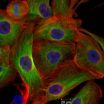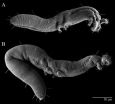(Press-News.org) SAN ANTONIO – Neuroblastoma is one of the most common and lethal types of childhood cancers. In a paper published online today in OncoTarget, a researcher at the University of Texas Health Science Center at San Antonio unveils the important role of microRNAs in regulating neuroblastoma development, pointing to new therapeutic possibilities.
Neuroblastomas, which account for 15 percent of childhood cancer deaths, happen when some cells do not differentiate and grow as they should. A promising type of therapy called differentiation therapy targets these malignant cells so that they can resume the process of differentiating into mature cells.
Unlike conventional chemotherapies, this new approach to cancer therapy has fewer toxic side effects, and gives hope for a cancer treatment that is gentler on young bodies. But so far only a few differentiation agents have been successfully used to treat neuroblastoma, and more than half of the young patients treated with such agents still see their cancer return.
To find new treatments, researchers needed improved laboratory screening techniques, and now one has been developed by Liqin Du, Ph.D., an assistant professor in the Department of Cellular and Structural Biology, and her team at the Greehey Children's Cancer Research Institute at the UT Health Science Center.
MicroRNAs are small RNA molecules involved in gene expression, and play an important role in cell development. This screening approach revealed several microRNA molecules that induce the process of cell differentiation, and those are key to developing new drugs.
"Development of new agents for treating neuroblastoma has been greatly hampered by the lack of efficient high-throughput screening approaches," Dr. Du said. "In our study, we applied a novel high-content screening approach that we recently developed to investigate the role of microRNAs in neuroblastoma differentiation.
"We identified a set of novel microRNAs that are potent inducers of neuroblastoma cell differentiation and found that mimics (synthetic fragments of nucleic acid used to raise microRNA levels in cells) of some of the identified microRNAs are much more potent in inducing neuroblastoma cell differentiation than the current differentiation treatments.
"These mimics are promising new drugs for neuroblastoma differentiation therapy," Dr. Du said. "We look forward to investigating this further in the future."
INFORMATION:
For current news from the UT Health Science Center, please visit our news release website or follow us on Twitter @uthscsa.
The Cancer Therapy & Research Center (CTRC) at The University of Texas Health Science Center at San Antonio is one of the elite academic cancer centers in the country to be named a National Cancer Institute (NCI) Designated Cancer Center, and is one of only four in Texas. A leader in developing new drugs to treat cancer, the CTRC Institute for Drug Development (IDD) conducts one of the largest oncology Phase I clinical drug programs in the world, and participates in development of cancer drugs approved by the U.S. Food & Drug Administration. For more information, visit http://www.ctrc.net.
Improved screening means new targets for pediatric neuroblastoma therapies
2014-03-01
ELSE PRESS RELEASES FROM THIS DATE:
It slices, it dices, and it protects the body from harm (Science)
2014-02-28
An essential weapon in the body's fight against infection has come into sharper view. Researchers at Princeton University have discovered the 3D structure of an enzyme that cuts to ribbons the genetic material of viruses and helps defend against bacteria.
The discovery of the structure of this enzyme, a first-responder in the body's "innate immune system," could enable new strategies for fighting infectious agents and possibly prostate cancer and obesity. The work was published Feb. 27 in the journal Science.
Until now, the research community has lacked a structural ...
Frequent childhood nightmares may indicate an increased risk of psychotic traits
2014-02-28
Children who suffer from frequent nightmares or bouts of night terrors may be at an increased risk of psychotic experiences in adolescence, according to new research from the University of Warwick.
The study, published today in the journal SLEEP, shows that children reporting frequent nightmares before the age of 12 were three and a half times more likely to suffer from psychotic experiences in early adolescence. Similarly, experiencing night terrors doubled the risk of such problems, including hallucinations, interrupted thoughts or delusions. Younger children, between ...
Study links poor sleep quality to reduced brain gray matter in Gulf War vets
2014-02-28
DARIEN, IL – A new study of Gulf War veterans found an association between poor sleep quality and reduced gray matter volume in the brain's frontal lobe, which helps control important processes such as working memory and executive function.
"Previous imaging studies have suggested that sleep disturbances may be associated with structural brain changes in certain regions of the frontal lobe," said lead author Linda Chao, associate adjunct professor in the Departments of Radiology and Biomedical Imaging and Psychiatry at the University of California, San Francisco. "The ...
Researchers identify brain differences linked to insomnia
2014-02-28
Johns Hopkins researchers report that people with chronic insomnia show more plasticity and activity than good sleepers in the part of the brain that controls movement.
"Insomnia is not a nighttime disorder," says study leader Rachel E. Salas, M.D., an assistant professor of neurology at the Johns Hopkins University School of Medicine. "It's a 24-hour brain condition, like a light switch that is always on. Our research adds information about differences in the brain associated with it."
Salas and her team, reporting in the March issue of the journal Sleep, found that ...
UCLA study finds robotic-assisted prostate surgery offers better cancer control
2014-02-28
An observational study from UCLA's Jonsson Comprehensive Cancer Center has found that prostate cancer patients who undergo robotic-assisted prostate surgery have fewer instances of cancer cells at the edge of their surgical specimen and less need for additional cancer treatments like hormone or radiation therapy than patients who have traditional "open" surgery.
The study, published online Feb. 19 in the journal European Urology, was led by Dr. Jim Hu, UCLA's Henry E. Singleton Professor of Urology and director of robotic and minimally invasive surgery in the urology ...
Let there be tissue-penetrating light: Scientists develop new nanoscale method to fight cancer
2014-02-28
Researchers from UCLA's Jonsson Comprehensive Cancer Center have developed an innovative cancer-fighting technique in which custom-designed nanoparticles carry chemotherapy drugs directly to tumor cells and release their cargo when triggered by a two-photon laser in the infrared red wavelength.
The research findings by UCLA's Jeffrey Zink, a professor of chemistry and biochemistry, and Fuyu Tamanoi, a professor of microbiology, immunology and molecular genetics, and their colleagues were published online Feb. 20 in the journal Small and will appear in a later print ...
Robert Avery, D.O., M.S.C.E., studies innovations to improve vision in children with tumors
2014-02-28
Robert Avery, DO, MSCE, of Children's National Health System and colleagues are establishing innovative approaches with technology and medication to improve the vision of young children who have visual pathway glioma, a type of brain tumor.
Most optic pathway gliomas cause vision loss in children between one and eight years of age. As many as 20 percent of children with neurofibromatosis type 1 -- a genetic disorder that occurs in 1 in every 4,000 births – may develop these tumors. It is estimated that nearly half of those children may experience vision problems from ...
Tackling tumors with space station research
2014-02-28
In space, things don't always behave the way we expect them to. In the case of cancer, researchers have found that this is a good thing: some tumors seem to be much less aggressive in the microgravity environment of space compared to their behavior on Earth. This observation, reported in research published in February by the FASEB Journal, could help scientists understand the mechanism involved and develop drugs targeting tumors that don't respond to current treatments. This work is the latest in a large body of evidence on how space exploration benefits those of us on ...
Worm-like mite species discovered on Ohio State's campus
2014-02-28
COLUMBUS, Ohio – It looks like a worm and moves like a worm – sort of. But it is a previously unidentified microscopic species of mite that was discovered by a graduate student on The Ohio State University campus.
Affectionately dubbed the "Buckeye Dragon Mite" by Ohio State's Acarology Laboratory, the mite is officially named Osperalycus tenerphagus, Latin for "mouth purse" and "tender feeding," in a nod to its complex and highly unusual oral structure.
This mite doesn't resemble a mythological winged dragon, but the snake-like Chinese dancing dragons that appear in ...
3-D imaging sheds light on Apert syndrome development
2014-02-28
Three dimensional imaging of two different mouse models of Apert Syndrome shows that cranial deformation begins before birth and continues, worsening with time, according to a team of researchers who studied mice to better understand and treat the disorder in humans.
Apert Syndrome is caused by mutations in FGFR2 -- fibroblast growth factor receptor 2 -- a gene, which usually produces a protein that functions in cell division, regulation of cell growth and maturation, formation of blood vessels, wound healing, and embryonic development. With certain mutations, this gene ...



